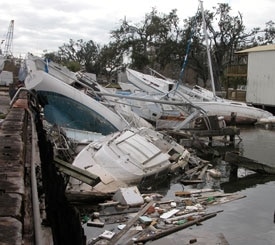
MarEditSt
Stepping onto the first dock at Orleans Marina, I took a picture of a 35-foot boat with a broken bowsprit and splintered headstay foil. Local boat dealer Stanton Murray chuckled and told me to save my shots for the real carnage. We were touring the New Orleans waterfront along Lake Pontchartrain in early January 2007, and as the photo of nearby Municipal Yacht Harbor shows, Stanton was right.
Seventeen months after Hurricane Katrina came calling, I saw no sign of dock repairs in a basin still littered with dozens of sunken or smashed-up boats. Here and there were boats tied up among the makeshift docks, especially in the corner where Southern Yacht Club has a temporary building. “We bump into things when we go out to sail,” said Stanton, gesturing across the harbor. “See any dock boxes?” (I didn’t.) “There were 700 of them here, and now most of them are on the bottom.” Ironically, a few miles east, dock boxes were the only thing still attached to the remnants of the piers at the still-ailing South Shore Harbor Marina.
The picture on the Mississippi coast was somewhat better. The towns east of where the eye of Katrina came ashore experienced a 30-foot storm surge that largely cleared out all the buildings along shoreside Highway 90. The marinas and yacht clubs were badly damaged or totally swept away. Some boats were deposited miles inland.
In Biloxi, the casinos and commercial wharves are now rebuilt or nearly so, but the only recreational marina with docks, fuel, and water was Point Cadet Marina (but there’s no shore power yet). The 250-slip marina in Gulfport Harbor was gutted and emptied of pilings, but approval for 364 new slips has recently come through. Across the harbor, the Gulfport YC has temporary quarters, partly rebuilt docks, and is set to start on its new clubhouse.
Farther west, in Long Beach Harbor and Pass Christian, I found a patchwork of docks and a smattering of boats. Winning the “most improved” award, back across the state line in Slidell, on the north side of Lake Pontchartrain, Oak Harbor Marina has three of eight piers rebuilt and more docks on the way.
If you’re inspired by Bill Howell’s story (see “Cruising America’s Other Waterway”) and you’re westbound from Florida on the Gulf Intracoastal Waterway, you’ll probably top off your tanks in Biloxi. When you get to Louisiana, you can find dockage, fuel, and water in Slidell or even New Orleans, where Seabrook Marine, on the Industrial Canal, is also fully operational, with fuel, water, Travelift, and dockage.
For local sailors, however, there’s a long row ahead. Privately owned facilities such as Seabrook and Oak Harbor are bright spots. Elsewhere, government agencies have made disappointing progress. Still, contracts have been awarded recently to clean out the Municipal Yacht Harbor, and its management corporation has new members and new energy. Under state oversight, work has also begun on South Shore Marina. Compared with the other challenges that New Orleans faces, the harbor projects are small. But a functioning waterfront is one more critical contribution toward getting the economy going again and making the city more livable for those who have returned.
To view the photo essay, click here.







